Executive Summary
NFC tags are small plastic devices with embedded NFC technology that enables communication between devices and that can be used in retail for engagement between consumers and brands.
NFC tags provide an inexpensive, easy way for retailers to increase engagement with customers, in two ways: 1) post-sale; and 2) in-store.
Post-Sale
- Retailers can deploy this technology in private-label goods such as apparel to engage with customers throughout the product lifecycle. This can include sending customers useful information or branded content.
- We think that many retailers stand to benefit from thinking more like brands in their approach to private-label goods. Retailers can adopt similar modes of engagement and product desirability, and yield benefits in terms of shopper preference and loyalty.
- Brands including casual-fashion firm Dyne and ski- and performance-wear brand Spyder have already introduced clothing with embedded NFC technology, to encourage customers to engage with the brands during the entire product lifecycle.
In-Store
- Retailers can use NFC as an in-store technology to interact with customers visiting their shops. Using their NFC-enabled devices, such as a smartphone or a tablet, shoppers can tap the tag associated with the item they want more information on.
- The use of NFC technology in-store can create a more targeted shopping experience for each shopper and can be used to showcase a wider product selection. Footwear-and-apparel brand Timberland and furniture retailer Made.com have launched interactive brick-and-mortar stores where shoppers can use NFC-enabled devices to access further product information and recommendations.
NFC technology is relatively straightforward to use. Surveys show that consumers tend to prefer NFC tags over competing technologies, and appreciate the speed, convenience and control they have when using it.
Companies cultivating their engagement with consumers should see a positive impact on revenue growth. Data show a positive correlation between engagement and sales growth. For example, British luxury brand Burberry shows a higher average engagement rate per Instagram post and faster-growing sales in 2016 compared to its competitor Mulberry.
Introduction
NFC tags are small plastic devices with embedded NFC technology that enables communication between devices and that can be used in retail for engagement between consumers and brands.
Retailers can gain competitive advantages from deploying NFC technology. In this report, we describe: 1)how NFC tags can help retailers to engage with customers during the product life cycle as well as in-store; 2) how consumers perceive their experience when using NFC tags versus competing technologies; and 3) the likely impact on revenue growth of an increase in engagement with consumers.
We highlight the case of Dyne and Spyder, two companies that embed NFC tags in their garments to encourage customers’ engagement with their brands, and show how Timberland and Made.com use the technology in their brick-and-mortar stores to engage with shoppers.
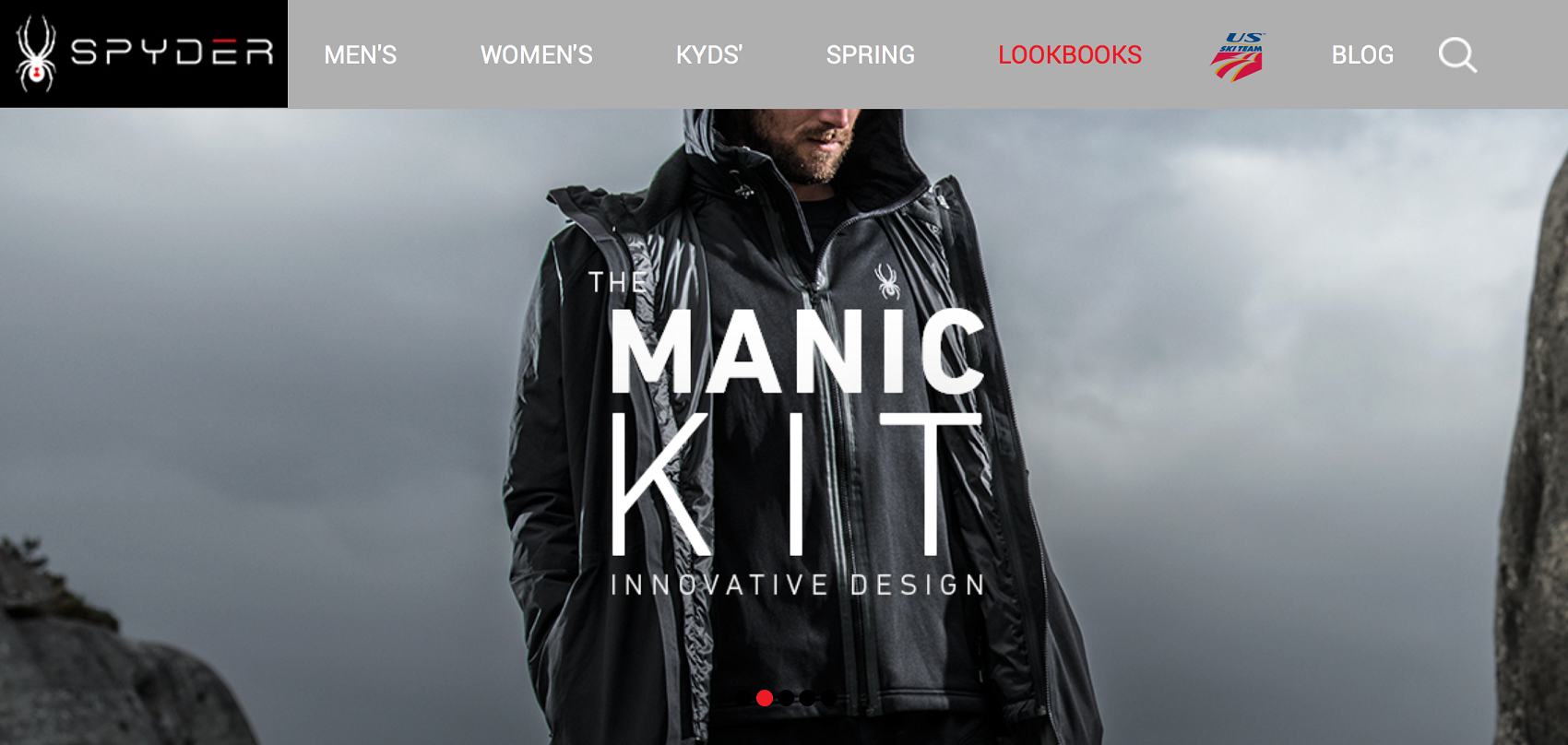
Source: spyder.com
We provide further details on the technical specifications of NFC tags and comparisons to other technology, in an Appendix.
NFC Tags Encourage Engagement with Customers
NFC tags provide an inexpensive, easy way for retailers to increase engagement with customers, in two ways:
- Post-sale: Retailers can deploy this technology in private-label goods such as apparel to engage with customers throughout the product lifecycle. This can include sending customers useful information or branded content, and in turn, can enhance the retailer’s image.
- In-store: Retailers can use it as an in-store technology to interact with customers visiting their shops. Using their NFC-enabled devices, such as a smartphone or tablet, shoppers can tap the tag associated with the item they want more information on.
The interaction enabled by NFC technology can improve the ability of retailers to engage with consumers. In particular, NFC can help with:
- Building customers’ brand engagement: NFC tags embedded in private-label branded garments can encourage customers’ engagement with the brand and brand loyalty by sending customers further information, such as branded editorial content, useful information such as local weather conditions and links to social media posts.
- In-store consumer engagement: Information sent by NFC tags in physical shops can help retailers engage with shoppers. For example, an NFC tag associated with the item picked up by the customer can interact with a smartphone or other digital device and suggest other colors available or matching articles.
- Measuring the impact of marketing: Retailers can measure the impact of their messages sent to consumers through NFC. For example, by campaign tagging the links that the marketing managers decide to include in NFC tags, they can accurately calculate the impact using tools such as Google Analytics.
- Encouraging store visits and repeat purchases: Information sent by NFC tags can encourage further store visits and create a sense of exclusiveness to reward loyal customers. For example, retailers can send notifications—through NFC tags embedded in the items previously purchased—about exclusive collections available in-store only to existing customers.
- Profiling consumers to make marketing personal and more effective: Once the shoppers access the links to social media or a transactional website sent via NFC tags, the information about their browsing preferences can be used by the retailer or by brand managers to profile the shoppers and to personalize the marketing messages directed at them.
There are other technologies that retailers can adopt in-store to create engagement with consumers. In our report,
IoT in Retail—Digitalizing Brick-and-Mortar Stores, we listed a number of technologies, from visible light communication (VLC) to smart shopping cart and virtual reality (VR).
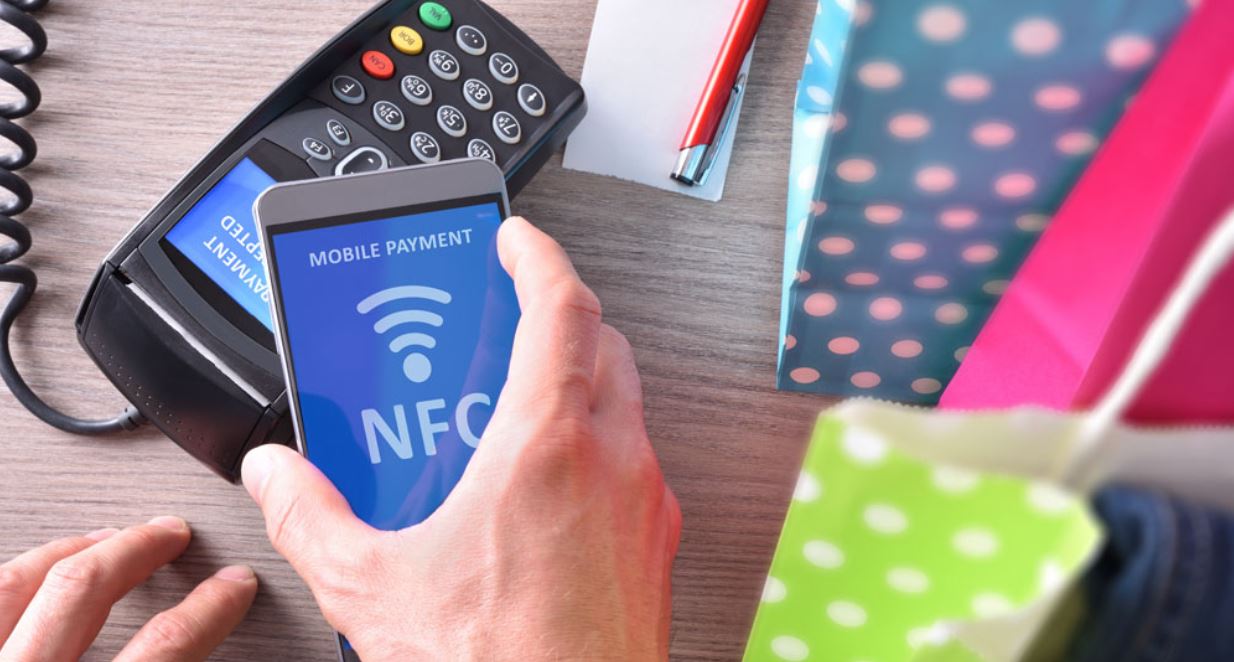
Source: Shutterstock
However, most of these solutions require substantial investment to be implemented, while NFC tags have the distinctive advantage of being both affordable and straightforward to adopt.
NFC Technology Can Help Generalist Retailers to Retain Market Share
NFC technology could give brick-and-mortar retailers a competitive advantage, and these possibilities look particularly useful for hard-hit retail sectors. For example, in the US, generalist brick-and-mortar retailers such as department stores have, in total, lost market share in recent years due to increased competition from online retailers and apparel and footwear specialist retailers.
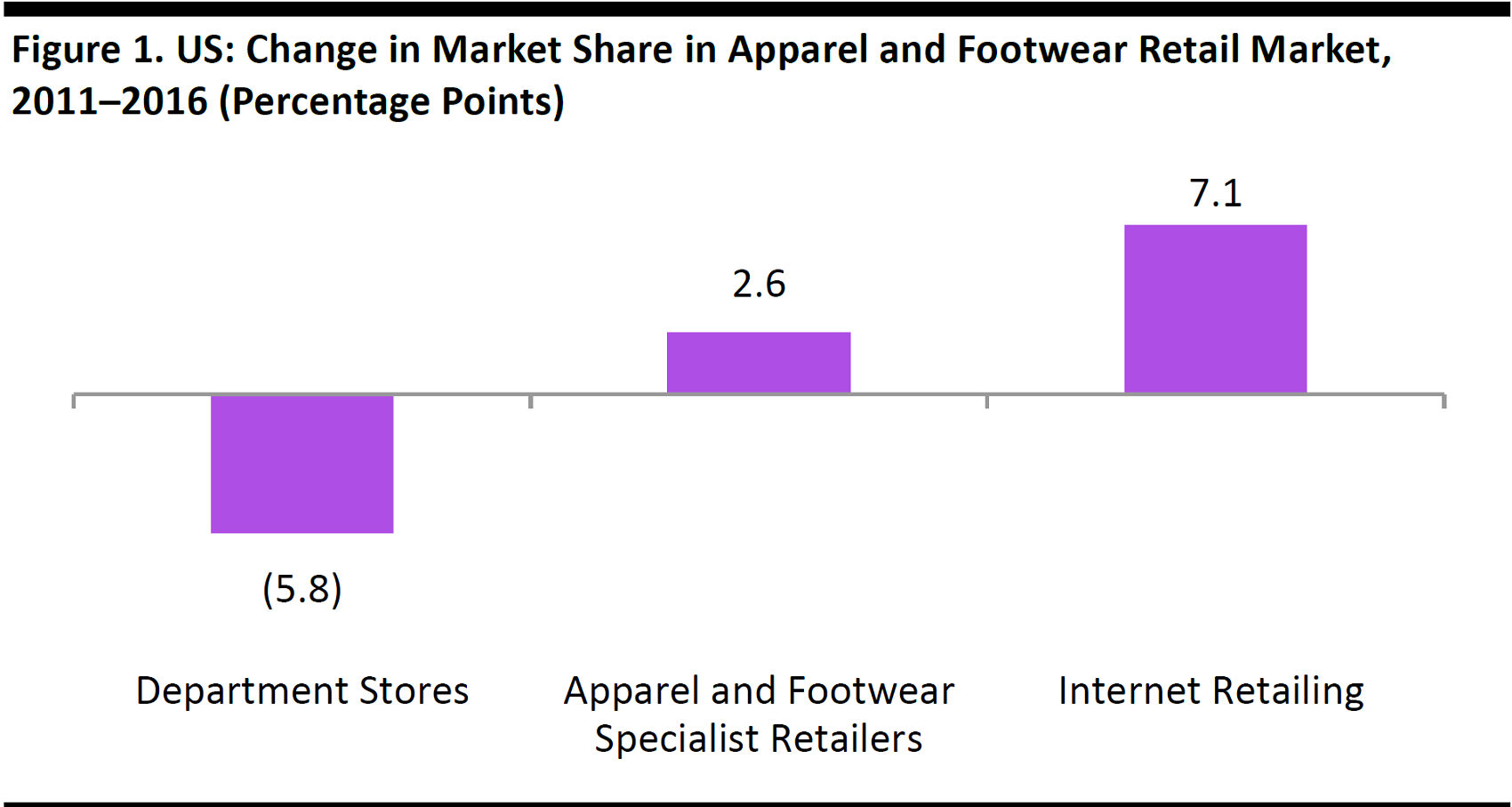
Source: Euromonitor International/Fung Global Retail & Technology
In the following sections, we outline in more detail the two major use-cases for retailers.
1. Retailers Can Think Like Brands by Adding NFC Tags to Private-Label Goods
Retailers can borrow the approach to NFC used by brands to cultivate shopper demand and loyalty. In particular, hard-hit retailers such as department stores can embed NFC tags in private-label products such as apparel in order to engage with shoppers post-purchase. As we noted earlier, this engagement can span editorial content, social media engagement and practical information.
This approach enables retailers to build stronger relationships with consumers throughout the product lifecycle, in turn, encouraging brand loyalty and repeat purchases. Moreover, beyond the opportunities for ongoing engagement, there is also a competitive advantage for retailers in offering an innovative type of product that direct rivals may not offer. In the mass market, such an approach may be one weapon against a paucity of differentiation and a simple race-to-the-bottom on price.
We think that many retailers stand to benefit from thinking more like brands in their approach to private-label goods. Retailers can adopt similar modes of engagement and product desirability, and yield benefits in terms of shopper preference and loyalty. In particular, retailers could look at strategies implemented by brands such as Spyder and Dyne, which embedded NFC technology in their apparel for customer engagement, as we profile below.
Brands Already Using NFC Tags: Dyne and Spyder
This section showcases examples of how two manufacturers generate brand engagement through NFC tags. Casual-fashion firm Dyne and ski- and performance-wear brand Spyder collaborated with tech firm Smartrac to introduce clothing with embedded NFC technology that encourages customers to engage with the brands during the entire product lifecycle.
Dyne: Post-Sales Brand Engagement
Dyne uses NFC technology to engage with customers from purchase through to the entire product lifecycle. Dyne’s garments embed a special NFC tag with enhanced environmental resistance developed by Smartrac. Users that wear the item can tap the NFC tag embedded in the fabric to get personalized content such as product information or links to lifestyle content such as music streaming on music app SoundCloud.

Source: smartrac-group.com
Spyder: NFC Turns Apparel into Experiences
Spyder, in collaboration with Li & Fung and Smartrac, launched a US Ski Team collection of NFC-enabled gear. The line, unveiled in October 2016, consists of items that can connect with consumer devices, thanks to embedded NFC tags. The technology enables users to access location-based information including weather and snow conditions and to interact in real time on social media.

Source: smartrac-group.com
2. Using NFC Tags for In-Store Engagement
Brick-and-mortar retailers can also use NFC tags as in-store technology to engage more with shoppers visiting their stores. The use of NFC technology in-store can create a more targeted shopping experience for each shopper and be used to showcase a wider product selection. Below, we show how Timberland and Made.com use NFC tags to engage with shoppers in-store.
Examples of In-Store Shopper Engagement through NFC Tags: Timberland and Made.com
In this section, we showcase examples of brands and retailers generating in-store engagement through NFC tags. Footwear-and-apparel brand Timberland and furniture retailer Made.com collaborated with retail tech firm CloudTags to launch interactive brick-and-mortar stores where shoppers can use NFC-enabled devices to access further product information and recommendations.
Timberland: NFC-Enabled Style Recommendations In-Store
Shoppers visiting Timberland’s Herald Square store in New York can borrow NFC-enabled tablets to engage with products in the shop. All items stocked in the outlet have a tag that shoppers can tap on the tablet to access content such as product information and recommendations. Products scanned can be added to a wish list and details emailed to the customer’s email address.
The use of in-store tablets gives shoppers the option to access information on the products and, at the same time, to retain control of what personal data they are giving out, since they are not using their own devices and can decide whether or not to enter personal data such as their email address. Timberland rolled out the in-store technology in collaboration with CloudTags.
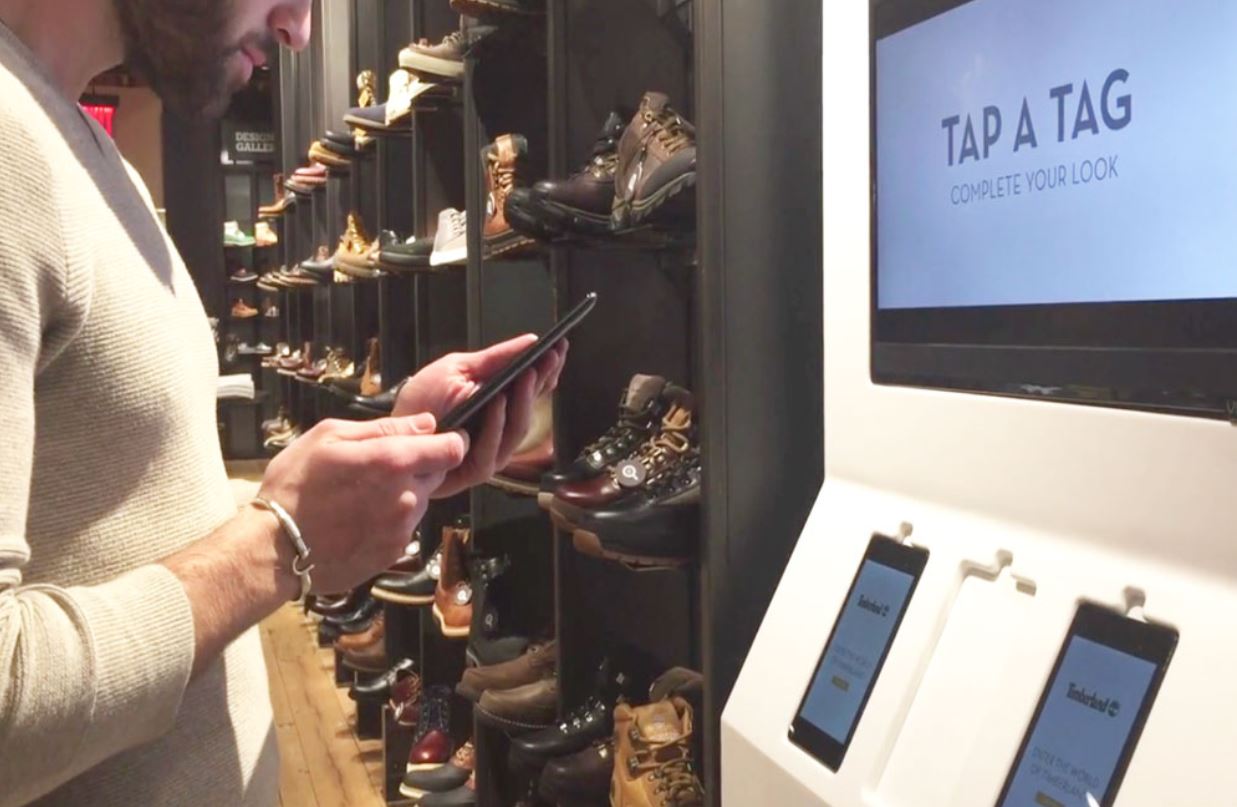
Source: CloudTags
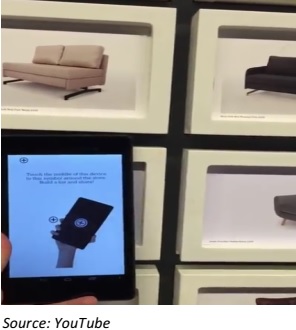 Made.com: NFC Technology allows the Entire Catalogue to be Displayed at the Showroom
Made.com: NFC Technology allows the Entire Catalogue to be Displayed at the Showroom
Made.com deployed NFC technology in its London showroom in 2014. As at the Timberland store, shoppers visiting the showroom can access product information and recommendations through tablets available in-store. They can tap on the NFC tags on the items displayed in-store or embedded in pictures of other products available through the online catalogue, but not stocked
in-store.
Made.com originated as an online-only retailer, and the use of NFC technology allows it to display its entire range in-store without the need to physically stock each item.
Consumers Favor NFC over Competing Technologies
In addition to being straightforward and affordable to implement for retailers and brand owners, NFC technology is also easier to use for shoppers and consumers, compared to competing technologies such as QR codes and Bluetooth-enabled Beacons.
The interaction between the retailer and the shopper enabled by NFC tags is very straightforward. An NFC tag transmits information immediately when the receiving device, such as a smartphone, reaches proximity, without the need for the user to take any further action. This transmission enables the user to receive content on their smartphone.
While users need only to tap the tag with their smartphones or tablets to receive information from NFC tags, competing technologies such as Beacons and QR codes require the user to take action in order to receive the information. In particular, users need to download and open dedicated apps to make use of Beacons and QR codes, and they need to activate Bluetooth to receive information via Beacons.
A 2014 survey undertaken by market research firm Strategy Analytics shows that US consumers favor NFC technology over QR codes and Beacons, and show a strong interest in using NFC in-store and in post-sales scenarios.
The participants in the survey indicated three significant benefits of using NFC:
- Speed: Consumers like the fact that NFC allows the user to get the information by simply tapping, rather than by having to launch an app (for Beacons) or to wait for a camera lens to focus, which is needed to scan a QR code.
- Convenience: Consumers said that in real-life situations, NFC is the most-convenient technology to use. For instance, the technology can be used regardless of what other functions their smartphones are performing simultaneously.
- Control: Respondents to the survey said that NFC gives them more control over the information they receive. With NFC, they can actively select which tags to tap, while with Beacons, they passively receive the information when they are in range.
The survey, conducted in the US, was undertaken among 36 participants who were asked to evaluate the use of NFC, QR code and Beacons in-store in different scenarios, such as accessing store deals, getting further product information, accessing a digital shopping card and ordering related items. The results of the survey were validated by interrogating a larger sample of 1,038 US consumers. Figure 2 summarizes the results of this larger survey.
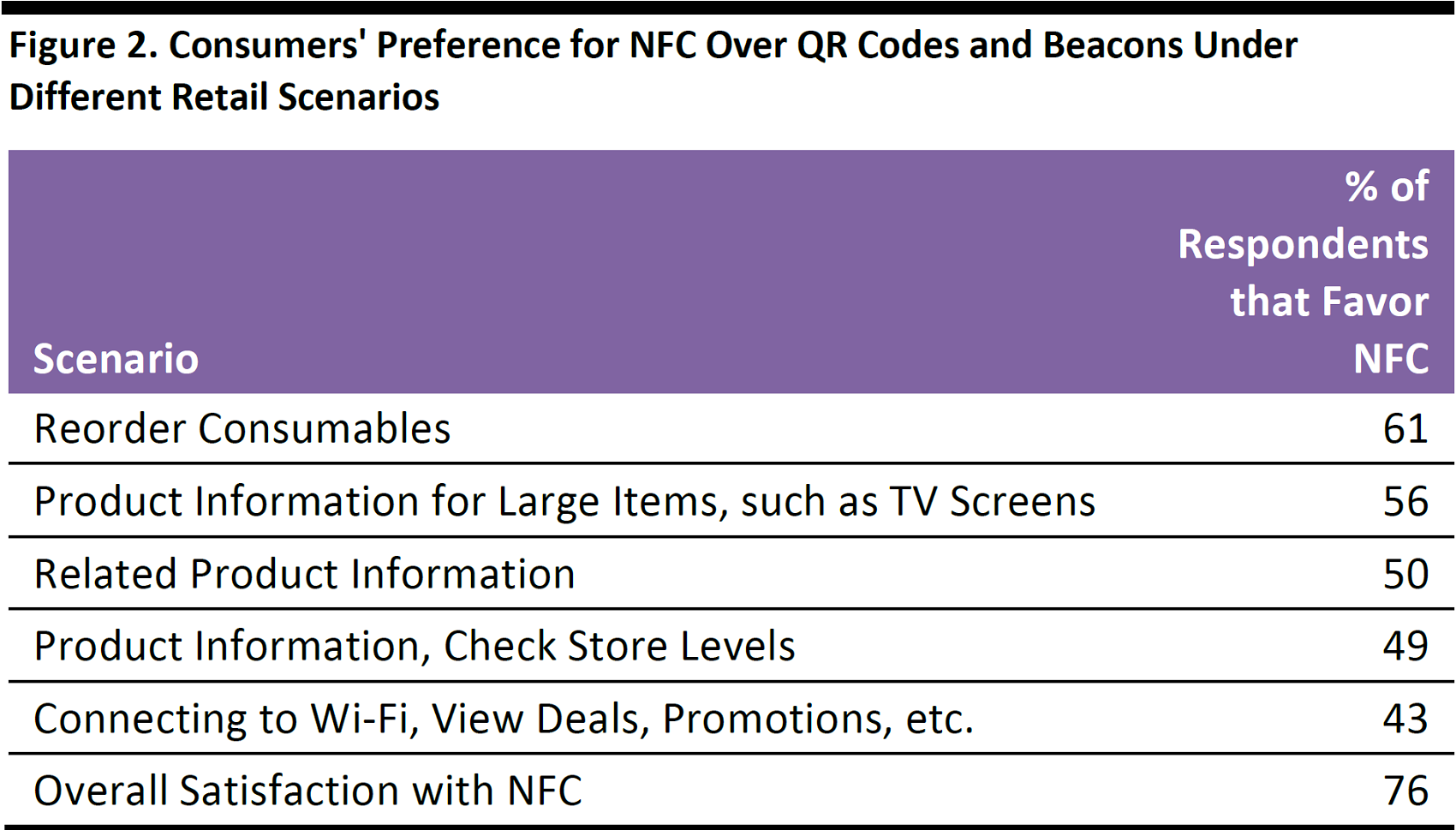
Base: 1,038 adult respondents
Source: Strategy Analytics
Engagement Can Contribute to Revenue Growth
As we have seen, consumer engagement through NFC tags has the potential of making marketing and operations more effective for brands and retailers. This, in turn, should reflect positively on a firm’s profitability.
The tangible impact of brand engagement on the bottom line is currently difficult to measure, given the lack of hard data on which to base the analysis.
Nevertheless, data on consumer engagement through Instagram and on UK sales for four leading UK-based luxury brands shows a positive correlation between engagement and sales growth, as illustrated in Figure 3. Burberry showed both the highest average consumer engagement rate per Instagram post and the fastest year-over-year UK sales growth rate in 2016. Conversely, Mulberry had the lowest engagement rate and the slowest UK sales growth during the same year.
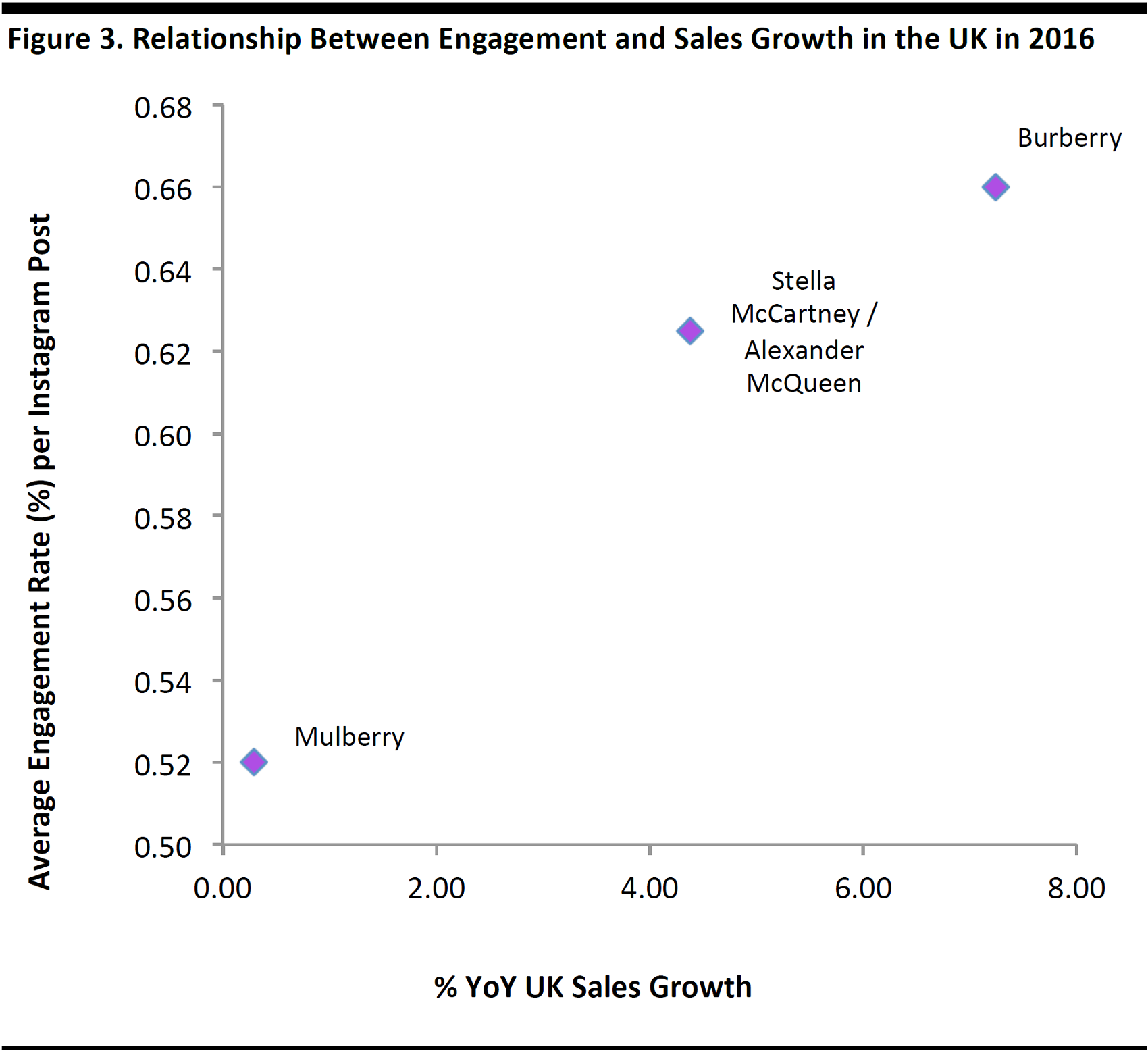
Average Engagement Rate measures the level of engagement that Instagram posts receive from the audience and is the ratio between the number of likes or comments and the number of followers. The metric is published by marketing firm PMX Agency. We assumed most engagement for UK-based fashion firms originates from the UK and we compared it with the sales growth in the same region to illustrate a correlation between the two metrics. Theaverage engagement rate for Stella McCartney (0.59) and Alexander McQueen (0.66) was averaged at 0.63 andKeringUK sales—the owner of the two brands—wereused for the two brands.
Source: PMX Agency/S&P CapitalIQ/Euromonitor International/Fung Global Retail & Technology
The relationship suggested in Figure 3 is just an example of how increased engagement can positively affect sales growth, but of course, several other factors are responsible for sales performance.
The use of NFC tags to engage with consumers is still relatively new for most companies, and as such, we do not yet have concrete data on the impact of NFC-induced engagement on sales performance.
However, we believe that what matters is the impact of customer engagement on performance, rather than the means through which the engagement is achieved. NFC technology looks to be a convenient and affordable way to achieve engagement.
Key Takeaways
NFC tags provide an inexpensive, straightforward and quick way to implement solutions that enable brick-and-mortar retailers to regain competitiveness. Retailers can use the technology in private-label products to engage with customers throughout the product lifecycle and in-store to interact with shoppers visiting their shops.

Source: Shutterstock
- Retailers can “think like brands” by including NFC technology in their own products, such as private-label apparel ranges. This would enable them to engage with shoppers post-purchase, for example, by sending customers branded content or useful information. Such an approach could benefit retailers through consumer preference and loyalty, and would provide a point of differentiation in terms of products.
- NFC tags can also be deployed as in-store technology to enable brick-and-mortar retailers to capitalize on their physical presence by engaging with shoppers visiting the store. Using their NFC-enabled device, shoppers can tap the tag associated with the item they want to get more information about.
NFC technology is relatively straightforward for consumers, and survey data show they prefer NFC tags over competing technologies and appreciate the speed, convenience and control.
Appendix: NFC Technology, NFC Tags and Technical Advantages versus Other Technologies
NFC is a short-range wireless connectivity technology that enables communication between devices.In retailing, the technology is used to facilitate the transmission of information from one device to another, with two main applications:
- Payments: With NFC-enabled payment systems such as Android Pay, payment information is transmitted from NFC chips installed in the smartphone to an NFC reader usually located in the proximity of the point of sales (POS) machine.
- Customer engagement: Retailers can use NFC technology to interact with consumers. For instance, in-store NFC devices send small pieces of information, such as links to promotional websites, to customers’ smartphones.
NFC tags are small plastic devices with embedded NFC technology and are used in retail for consumer and brand engagement. The tags send information to consumers’ smart devices when they are in close proximity to the product. NFC tags have very limited storage capacity—ranging from 48 bytes to 2 kilobytes—which is enough to transmit a very simple piece of information, such as a link to a website.
The tags display features that make the technology most suitable for mass adoption in retail:
- Cost: NFC tags are inexpensive. Prices range depending on the storage capacity and the physical support, which is usually a plastic sticker or a hard plastic disk. At the time of writing, a set of 10 sticker NFC tags with a 144-byte memory was sold on Amazon at £5.95 (US$7.37).
- No power requirements: NFC tags are passive devices which rely on an active device (such as a smartphone) that comes into range for activation. The tags are powered through electromagnetic induction coming from the active device, and as such, do not need an autonomous power supply to function.
- Speed: NFC tags transmit data immediately to the active device when the device comes into range. This means that there is no need for the users to take any further action to receive the information on their device.
- Supported by most smartphones: Most smartphones contain NFC chips and can act as active devices that enable the NFC tags to work. However, at the time of writing, NFC readers in iPhone smartphones do not support any type of NFC technology apart from payment terminals for ApplePay.
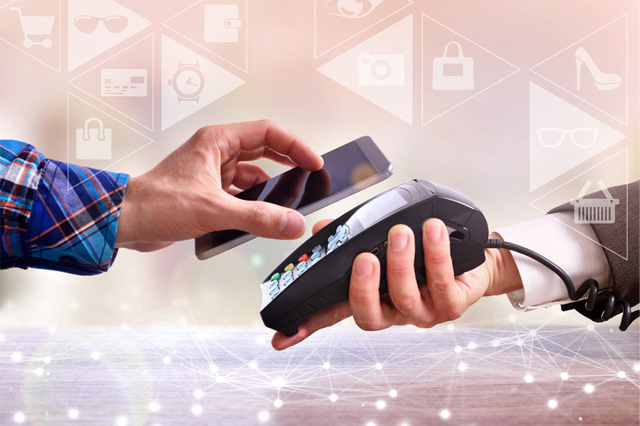






 Made.com: NFC Technology allows the Entire Catalogue to be Displayed at the Showroom
Made.com: NFC Technology allows the Entire Catalogue to be Displayed at the Showroom
